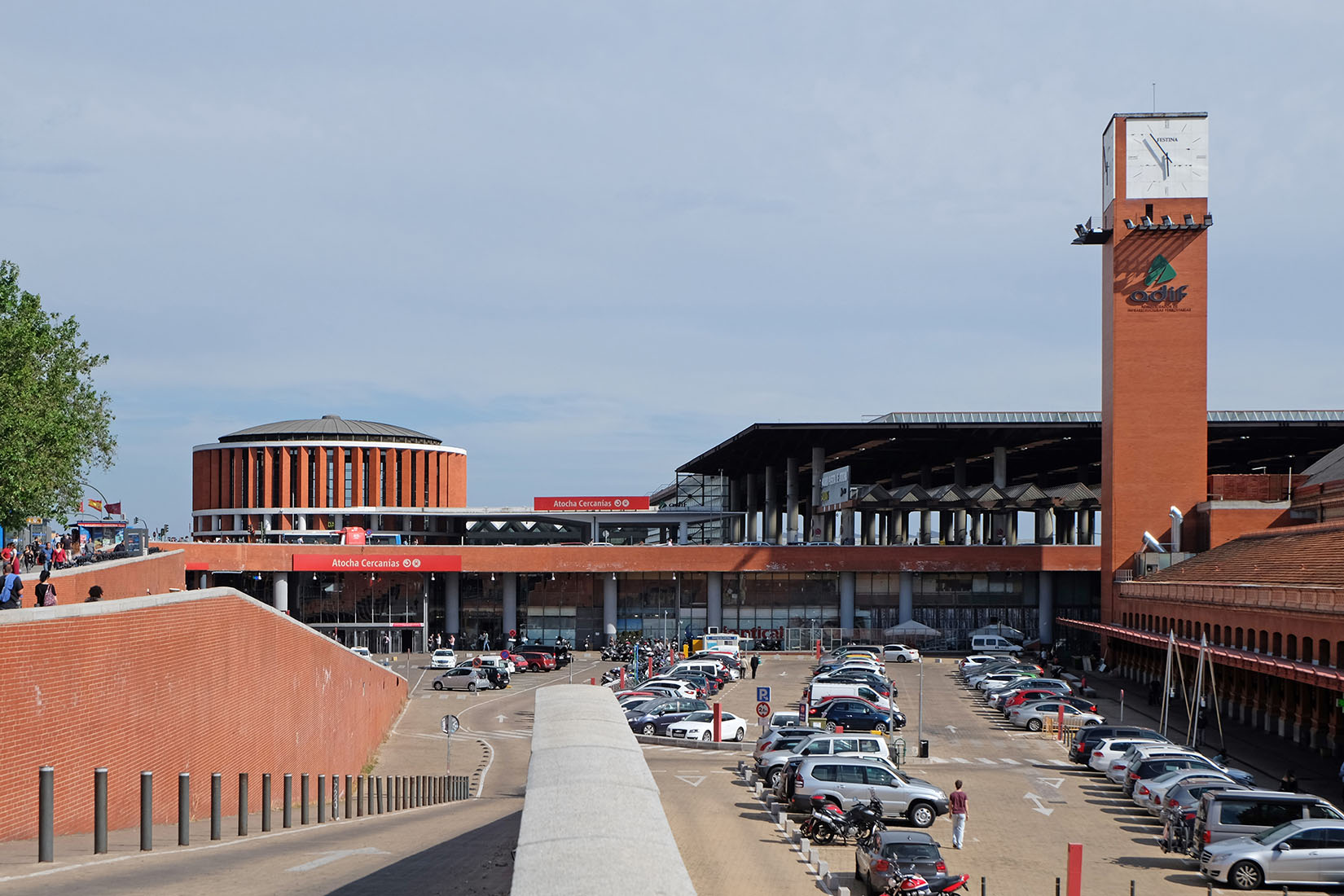 |
 |
 |
 |


Atocha Train Station Extension
Plaza del Emperador Carlos V, Madrid
1985 - 1992
In the years 1985 to 1992, the Spanish architect Rafael Moneo
expanded the Atocha station. The expansion should quadruple the
capacity of the station, which was originally designed as a terminus
station, and is famous for the large roof construction made of glass
and cast iron. This building was built between 1888 and 1892 in the
style of the art nouveau by the architect Alberto de Palacio y
Elissague. The huge glass roof now covers a tropical palm garden, with
the converted space used as a waiting room and meeting place. The old
station building was complemented with a clock tower. The concept of
Rafael Moneo also includes a new station square, new roofing for the
tracks, covered parking and a new driveway. The converted and expanded
station consists of two main components. In a subterranean transit
station operate the regional trains and commuter trains, while the
long-distance trains continue to use the terminus station. The station
gained a sad fame on March 11, 2004 through the Madrid train assaults
in the morning rush hour.
In den Jahren 1985 bis 1992 erweiterte der spanische Architekt Rafael Moneo den Atocha Bahnhof. Durch die Erweiterung sollte die Kapazität der Anlage vervierfacht werden. Dieser Bahnhof wurde ursprünglich als Kopfbahnhof angelegt, und ist berühmt für die grosse Dachkonstruktion aus Glas und Gusseisen. Dieser Bau wurde zwischen 1888 und 1892 im Jungendstil durch den Architekten Alberto de Palacio y Elissague errichtet. Unter diesem riesigen Gladach befindet sich seit dem Umbau des Bahnhofs ein tropischer Palmengarten, wobei der umgewandelte Raum als Wartehalle und Treffpunkt genutzt wird. Das alte Bahnhofsgebäude wurde zudem mit einem Uhrurm ergänzt. Das Konzept vor Rafael Moneo beinhaltet zudem einen neuen Bahnhofsplatz, neue Gleisüberdachungen, gedecke Parkpltze sowie eine neue Vorfahrt. Der umgebaute und erweiterte Bahnhof besteht aus zwei Hauptbestandteilen. In einem unterirdischen Durchgangsbahnhof verkehren die Regionalzüge und S-Bahnen, während dem die Fernzüge im weiterhin als Kopfbahnhof genutzten überiridschen Bahnhof einfahren. Traurige Berühmtheit erlangte der Bahnhof am 11. März 2004 durch die Madrider Zuganschläge in der morgendlichen Hauptverkehrszeit.
In den Jahren 1985 bis 1992 erweiterte der spanische Architekt Rafael Moneo den Atocha Bahnhof. Durch die Erweiterung sollte die Kapazität der Anlage vervierfacht werden. Dieser Bahnhof wurde ursprünglich als Kopfbahnhof angelegt, und ist berühmt für die grosse Dachkonstruktion aus Glas und Gusseisen. Dieser Bau wurde zwischen 1888 und 1892 im Jungendstil durch den Architekten Alberto de Palacio y Elissague errichtet. Unter diesem riesigen Gladach befindet sich seit dem Umbau des Bahnhofs ein tropischer Palmengarten, wobei der umgewandelte Raum als Wartehalle und Treffpunkt genutzt wird. Das alte Bahnhofsgebäude wurde zudem mit einem Uhrurm ergänzt. Das Konzept vor Rafael Moneo beinhaltet zudem einen neuen Bahnhofsplatz, neue Gleisüberdachungen, gedecke Parkpltze sowie eine neue Vorfahrt. Der umgebaute und erweiterte Bahnhof besteht aus zwei Hauptbestandteilen. In einem unterirdischen Durchgangsbahnhof verkehren die Regionalzüge und S-Bahnen, während dem die Fernzüge im weiterhin als Kopfbahnhof genutzten überiridschen Bahnhof einfahren. Traurige Berühmtheit erlangte der Bahnhof am 11. März 2004 durch die Madrider Zuganschläge in der morgendlichen Hauptverkehrszeit.